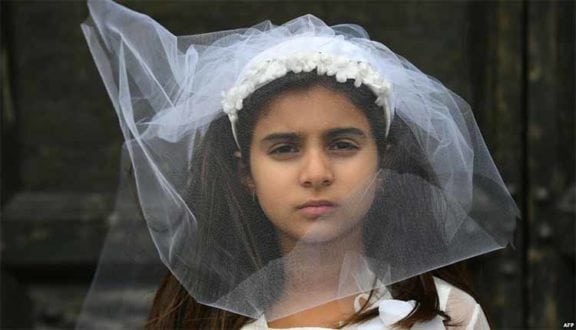Iranwire – On August 29, the secretary of Iran’s National Authority on the Convention on the Rights of the Child confirmed something that many had assumed for years: the real the number of child marriages in Iran is higher than the official figures.
In an interview with the Iranian Students’ News Agency (ISNA), Mahmoud Abbasi, Deputy Justice Minister for Human Rights, conceded: “International organizations have questioned the situation in Iran regarding child marriage.” Some families, he said, marry their daughters off in religious ceremonies before they turn 13 – and when they reach that age, they go to court and formalize the marriage in law.
Describing this as “bypassing the law”, he added: “The children of unofficial child marriages [also] have no ID documents until the marriage of their parents is officially registered.” Some of the child marriages newly registered in the past few years, he said, had involved brides under the age of 10. A girl of nine gave birth to three children in three years and was then divorced.
Many women’s rights activists and sociologists critical of the Islamic Republic’s policies on children’s rights believe that raising awareness about this issue in the international sphere might help bring about change. But others are more sceptical, fearing the regime will not budge on this issue regardless of the external pressure.
In his interview, Abbasi pointed to poverty as the major factor driving child marriage in Iran. Some families, he said, were known to have married off their underage daughters in exchange for just one million tomans (about US$242).
The Statistical Center of Iran put the number of Iranian girls between 10 and 14 years of age who were married in 2020 at 31,379: itself an increase of 10.5 percent compared to that recorded a year before.
Child Marriage as Sexual Slavery
Saeed Peyvandi, a sociologist and university professor based on France, has observed trends in child marriage in Iran and also believes there is a direct relationship between child marriage and income.
“Child marriages usually take place in underprivileged areas,” he said. “It happens less in those families that have an education going past high school, or who are not struggling with absolute poverty. If they are more financially comfortable, even those who support and promote child marriage prefer their daughters get an education and marry after they turn 18.”
He added: “Field studies showed families usually have two motives when agree to marry off their daughters when they are still children. The first is to provide their daughters with relative financial support. The second is to improve the financial status of the wider family. A high number of children in a poor family prompts the parents to transfer financial responsibility for the child to somebody else, without considering the consequences.
“There have been cases where families have agreed to marry off their daughters to men more than 40 years their senior; it has even happened that the husband has been so old, he has died a couple of years after marrying the child.”
Saeed Peyvandi believes the wider policies of the Islamic Republic makes this social crisis worse: “Granting lavish marriage loans to underprivileged groups can change their lives in a tangible manner, and exacerbates this social problem.”
In his view, child marriage is tantamount to selling children into sexual slavery: “Some officials of the Islamic Republic justify child marriage in terms of ‘solving the low birth rate crisis’ or ‘safeguarding society’s moral integrity’. But the fact is that child marriage is a form of trafficking and slavery.”
Failed Attempts at Reform of Child Marriage Law
In recent years there have been several stalled efforts to reform the laws related to child marriage in Iran. MPs tried to introduce a bill to increase girls’ minimum marriageable age to 16, and boys to 18, but it was thrown out amid opposition from a handful of clerics. In Shia Islamic jurisprudence, marriageable age is nine for girls and 15 for boys. The Islamic Republic considers 13 to be the minimum age.
Javaid Rehman, the Special Rapporteur on the situation of human rights in the Islamic Republic of Iran, decried the situation in a report to the UN General Assembly in March 2021: “One of the most worrisome issues in today’s Iran when it comes to the rights of women and girls is the issue of child marriage,” he wrote. “The Government and other leaders in the country must raise the marriageable age now, and introduce further policies and programs to reduce this practice in the country.”
Peyvandi is pessimistic that raising awareness of the practice in the international community alone will do much to change the situation inside Iran. “International institutions historically haven’t done much about child marriage. As a result, the Islamic Republic continues on its disastrous course year after year without fear of consequences.” By contrast, he noted, a threat by FIFA to suspend Iran saw women allowed back into some football stadiums. “If Iranian activists raise their voices and engage with institutions such as UNICEF, UNESCO and other institutions that support the Convention on the Rights of the Child, Islamic Republic officials might not be able to just declare that their own laws are being ‘bypassed’ and carry on as usual.”
Why do the Victims of Child Marriage Stay Silent?
Mehrangiz Kar, an Iranian lawyer and human rights activist who now resides in the US, also says civil rights activists haven’t done as much work on child marriage in Iran as they have for certain types of discrimination against women, such as inheritance, the right to divorce and child custody. “The reason,” she says, “is that in this case the victims, that is the child brides, have no voice. These girls are under the thumb of their families and after they are married, they are controlled by their husbands.”
She agrees that the root cause of most child marriages is poverty. Some of these girls, she told IranWire, are compelled to stay silent or else face destitution. In addition, endemic censorship in Iran stops their stories from finding their way out: “Even if journalists and activists approach these victims and talk to them about what they’ve been through, there’s little chance that they can tell the public about it. Neither the papers nor state-run radio and TV can explicitly talk about the social ills caused by child marriage.”
The Role of the International Community
Samaneh Savadi, an Iranian lawyer and gender equality activist based in the UK, says that social, cultural and economic factors that lead to child marriages are intertwined. As a result, “This problem can’t be solved through a handful of specific actions. Child marriage is directly related to poverty, and even to environmental and cultural issues. It’s been reported that child marriage has increased in places that have been hit by droughts and famine. Why? Because the family wants somebody else to provide for their child.
“It’s simplistic to believe the international community is unaware of child marriage in Iran. The international community is well aware of it, because this problem is not limited to Iran. Holding governments accountable isn’t just about awareness-raising but the will to confront those that permit this violation of human rights.”
The journalist and women rights activist Naeimeh Doostdar, however, believes that raising awareness by itself can have positive effects: “It can increase pressure on Iranian officials, even if they pretend that they don’t care.” Keeping up appearances is important, she says, and besides, Iran wants to keep receiving aid from the international community and retain its membership of international bodies.
Protesting against these practices has a symbolic value as well, she says: “The voices of opposition demanding change can change some parts of public opinion. This isn’t a small achievement, even if the government does not change radically as a result.”
 Shabtabnews In this dark night, I have lost my way – Arise from a corner, oh you the star of guidance.
Shabtabnews In this dark night, I have lost my way – Arise from a corner, oh you the star of guidance.



